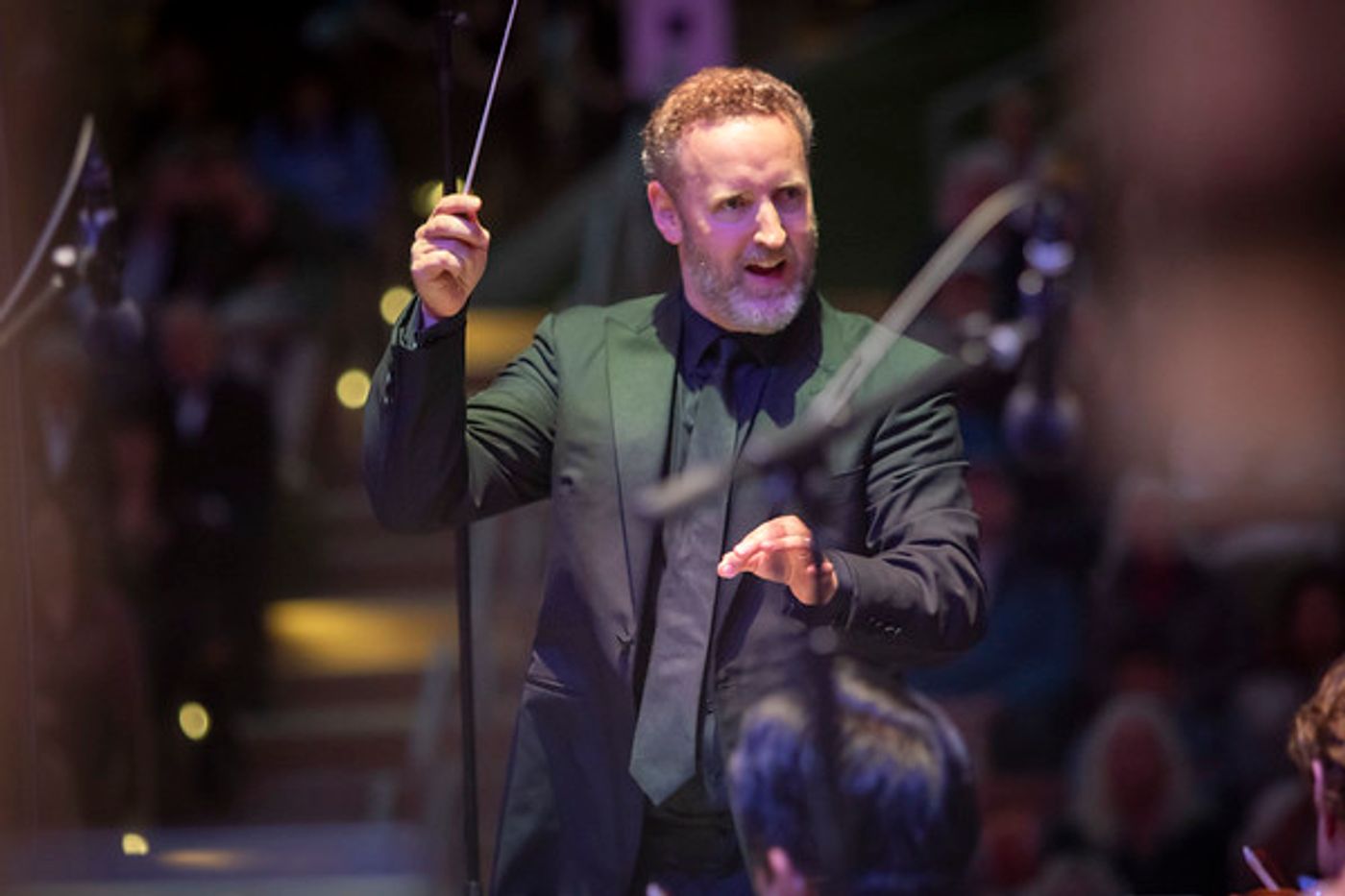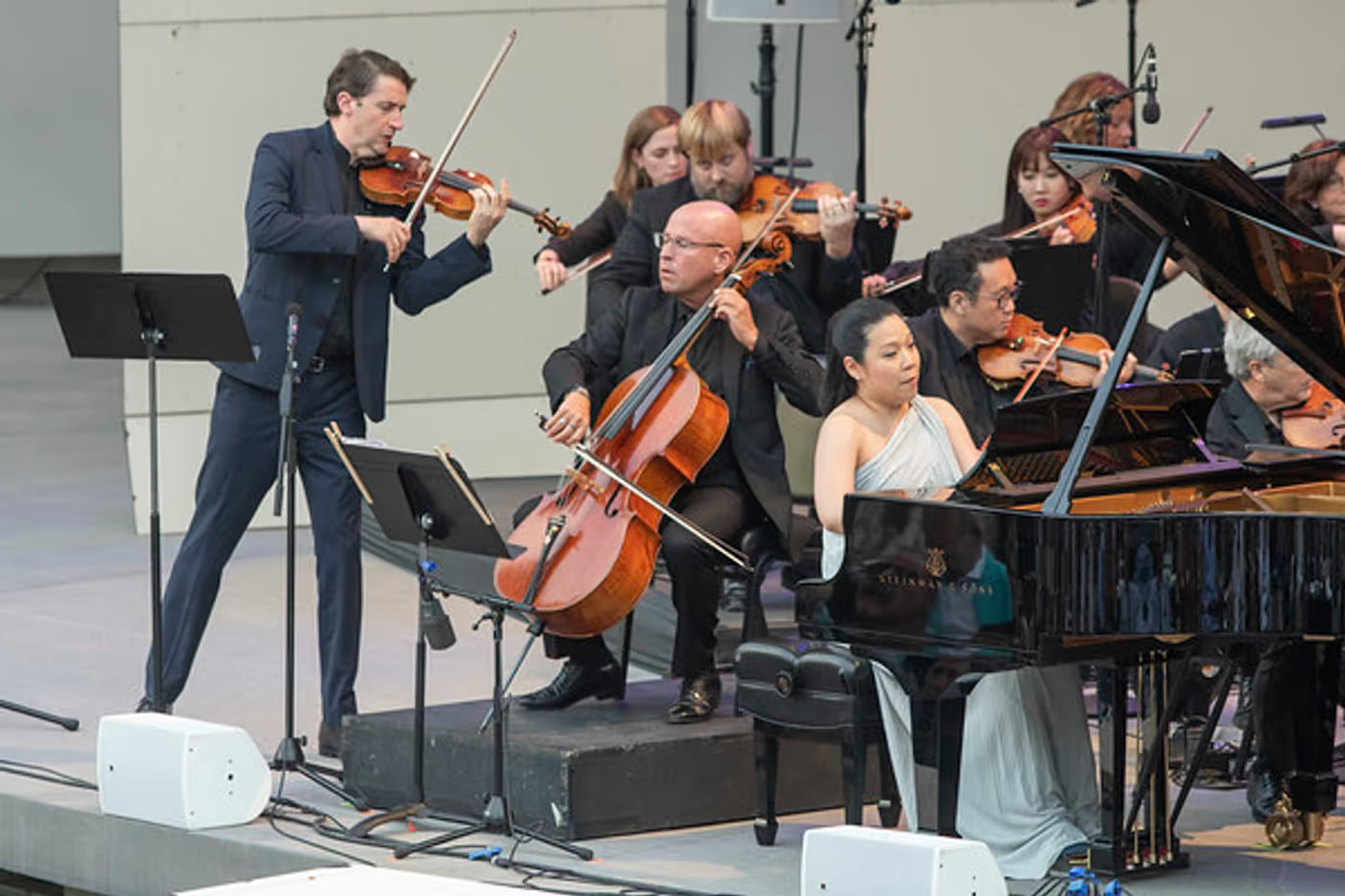Review: THE MAINLY MOZART ALL-STAR ORCHESTRA at the Epstein Family Amphitheater
Read BroadwayWorld's review of the concert here!

Michael Francis is the conductor and music director of the Mainly Mozart festival All-Star Orchestra. The “All-Star” designation isn’t hyperbole. The Orchestra includes Concertmasters, first chairs and other top players from some of the world’s finest symphony orchestras including those of Boston, Chicago, Philadelphia, Cleveland, San Francisco, Los Angeles, Berlin, and New York.

Francis’ introductions to a program’s music are informative and delivered with a sly charming wit. But his demeanor changes to that of a forceful and demanding conductor once the music begins.
At this concert, the summer season’s finale, it began with Mozart’s playful overture to Così fan tutti followed by Beethoven’s "Triple Concerto." After a short break, the concert concluded with Beethoven’s Seventh symphony, a major break from Classical forms and a transition to the Romantic era.
Così fan tutti Overture
Mozart wrote Così fan tutti in collaboration with librettist Lorenzo Da Ponte who also wrote The Marriage of Figaro and Don Giovanni. The opera’s overture is a bubbly delight and even more so in a performance by the Mainly Mozart orchestra. Francis took full advantage of his best-of-the-best orchestra musicians with racing tempos, sharp dynamic contrasts and effective tempo changes.
Beethoven's Triple Concerto
The light-weight overture was a surprisingly good prelude to Beethoven’s "Triple Concerto" for piano, violin and cello. According to Discogs, the composer’s violin concerto and five piano concertos each appear on from 9000 to 13,000 recordings including reissues. The "Triple Concerto" tops out below 1,000. Critics have often criticized it for frequent repetition, and a lack of the composer’s usually more inventive and elaborate thematic development. The need for three excellent soloists is a second factor, and the cello score is especially demanding.
I’ve certainly heard the work far less often than any of Beethoven’s other six concertos and this was the first time I’d heard it in a live concert. I never thought that was a significant loss -- until this performance changed my mind.

The three soloists displayed riveting virtuosity and meshed as though they were an established touring trio, listening carefully to each other for mood, tempo and dynamic changes.
The concerto was composed for Beethoven’s pupil and patron the Archduke of Austria, a good amateur pianist who wanted to play the keyboard part with his private orchestra. The piano has the easiest of the three solo parts. It’s good to be the emperor’s son!
Ease isn’t a requirement for Grammy-nominated pianist Joyce Yang, and after the slow introduction, Francis called for a blistering pace, correctly confident that she, Concertmaster of the Berlin Philharmonic Noah Bendix-Balgley and Principal Cello of the Los Angeles Philharmonic Robert deMaine wouldn’t miss a note. As her fingers continued to fly across the keys, Yang even managed a delightful show of turning with a smile to the soloists who were behind her to be sure of the timing before she gave way to one of them.
As the three took turns with the often-repeated melodies of the delightful first movement, the repetition established a playful mood of collaboration, and thematic development was replaced largely by changing timbres. It was quite a contrast to Beethoven’s usual depth of serious emotion and profoundly effective use of classical forms.
Heartfelt sonority is the key to the beautiful second movement, and both soloists and orchestra appropriately performed it as though from the Romantic rather than Classical era. The third movement returns to the sparkling fun of the first with a jaunty polonaise rhythm and simple themes repeated in sequence by the soloists and orchestra with minimal variation.
Beethoven's Seventh Symphony
Richard Wagner called Beethoven’s Seventh symphony “the apotheosis of dance” because each of its four movements has its own well-defined and distinctive rhythm. I think of it instead as an expression of the composer’s intensely emotional approach to music. It combines the Sixth symphony’s pleasurable stroll through a bucolic setting with the Fifth’s fierce determination in the face of nature’s crueler side.
A repetitive, upbeat military-sounding march rhythm dominates the first movement. A related rhythmic pattern invokes the feeling of Calvary on the move.
The second movement has the feel of a beautiful somber hymn briefly interrupted by a brighter interlude. The movement was a frequently requested encore in the years following the Seventh’s premiere.
The exhilarating Scherzo features a lively joy and good-natured wit, this time with a contrasting tender interlude before simple pleasure returns.
Beethoven biographer J.W.N. Sullivan aptly describes the final movement as a “region of pure ecstasy, a reckless, headlong ecstasy, a more than Bacchic festival of joy.” Add a fiercely driven tempo to that and there is no better description of Francis’ interpretation as he again successfully tested the All-Star orchestra’s skill with a marvelous result – gorgeous sounds from both the ensemble and soloists, flawless entrees, and superb section balances and dynamics.
The size of the Festival Orchestra, roughly half that of the usual modern symphony orchestra, is a better fit for many Classical era compositions. Modern conductors often allow the strings to dominate making it more difficult to hear a work’s inner lines and the balances composers likely had in mind. On this program, the smaller size was an advantage in the Mozart and the "Triple Concerto." For Beethoven’s Seventh, the advantage disappears. It works at either size.
I can’t resist a few paragraphs on the life of Mozart’s best-known librettist and how it affected the premiere production of Cosi fan tutti.
For many years Da Ponte was the most in-demand Italian opera librettist. During his life he collaborated with well-known composers on 28 operas.
He was born in the Republic of Venice in 1749 and later moved to the city of Venice. Though an ordained Roman Catholic priest, for more than 20 years he was a close friend of adventurer and seducer Giacomo Casanova, and in 1779 was convicted of living in a brothel and organizing its entertainments. Da Ponte may have modeled Don Giovanni after himself and Casanova.
Banished from Venice, he traveled widely in Europe and eventually fled from London to the United States with his mistress Nancy Grahl to escape severe financial difficulties. Though never married, the couple had four children together.
in 1805 Da Ponte became a U.S. citizen, and after several business projects that included a grocery store, he became the first professor of Italian literature at Columbia College in New York. At 84 he built a concert hall that was the nation’s first designed specifically for opera. True to his past, it failed two years later.
"Cosi fan tutti’s" history has its own moments. Mozart disliked Da Ponte’s mistress (at that time), Adriana Ferrarese del Bene for whom the main soprano role of Fiordiligi had been written. He knew she had a habit of suddenly lifting her head on high notes and dropping it for low ones. According to British critic William Mann, the showpiece aria "Come scoglio" was designed to make her look like a chicken bobbing its head up and down for chicken feed.
For Mainly Mozart’s remaining concert schedule of this year visit its website.
San Diego classical music lovers should consider participating in Mainly Mozart's current fund-raising campaign. The organization attracts the world’s best musicians and operates young people’s orchestras with a surprisingly small budget and staff.
Top photo Ken Jacques
Reader Reviews

Videos

